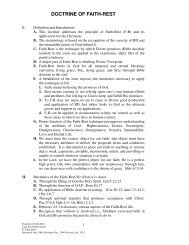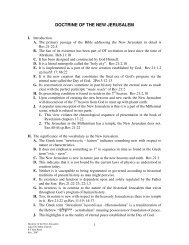Revelation 9 - Lake Erie Bible Church
Revelation 9 - Lake Erie Bible Church
Revelation 9 - Lake Erie Bible Church
You also want an ePaper? Increase the reach of your titles
YUMPU automatically turns print PDFs into web optimized ePapers that Google loves.
Chapter 9<br />
THE REVELATION TO JOHN<br />
ANALYSIS VERSES 1 – 2:<br />
1. Chapter 9 now assumes the new face of the grouping patterns as previously illustrated<br />
for the trumpet judgments.<br />
2. It is two-fold and introduces us to the next unit of 2 of the 4,2,1 pattern as well as the<br />
new 4,3 pattern with the 1 st of the triple woes. Rev.9:12<br />
3. As we pointed out, the 1 st 4 trumpets form a unit and delineate the horrific results of<br />
the nuclear attack on the U.S as it applies predominately to the physical environment.<br />
4. The 5 th trumpet now introduces us to the next unit of 2 denoting judgments reserved<br />
predominately for men.<br />
5. As the 1 st of the woes, it indicates an escalated judgment directly associated with the<br />
destruction of the U.S. being the eagle of 8:13.<br />
6. Therefore, it maintains the same force of the terminus ad quo of the 1 st 4 trumpets<br />
chronologically preceding the Day of the Lord.<br />
7. John again reveals this new vision with the visual of an eyewitness, “And the fifth<br />
angel sounded, and I saw a star from heaven which had fallen to the earth”.<br />
8. As most interpreters agree, the star now in view is metaphorical symbolizing an<br />
angelic being.<br />
9. The doubt otherwise is removed based on the principle of authority and power<br />
attributed to it as well as a personal pronoun in vs.1b, “and the key of the bottomless<br />
pit was given to him”.<br />
10. This clause gives the star in view personality and otherwise a human characteristic to<br />
open a lock with a key.<br />
11. This single angel in view is described as having fallen to the earth by means of a<br />
perfect participle that indicates he fell in the past and was residing on the earth.<br />
12. This perfect participle indicates that John did not see this angel fall as revealed in our<br />
verse, but saw him after the fact having taken up his new position.<br />
13. The commentary of Mounce calls this participle a dramatic perfect translating it as<br />
“which had just fallen” that is a good explanation of the timing of this event that<br />
occurs prior to the mid-point of Daniel’s 70 th week.<br />
14. This scenario harks back to the 6 th seal of 6:13 that indicates angels falling to the<br />
earth, an event as we saw that was directly affiliated with the destruction of the U.S.<br />
15. The verb “had fallen/p i , p t w – pipto” is used 3x in the perfect tense in the NT and the<br />
other 2 usages indicate a fallen condition as something less than desirable. Act.15:16;<br />
Rev.2:5<br />
16. While most recognize that this is an angel, the exact identification and whether it is<br />
elect or fallen is debated to include:<br />
A. Kiddle, Walvoord and Sweet believe it has to be a demon.<br />
B. Some identify it as Satan himself based on the fact that this fits the imagery of<br />
Rev.12:7-9 that indicates he was cast to the earth. Cp.Rev.12:14<br />
C. They further suggest that this builds on the imagery of Isa.14:12-14 that describes<br />
Lucifer as the morning star that had fallen to the earth.<br />
D. Beale feels strongly that this is an evil angel sent from God and argues that in the<br />
OT and Jewish writings a falling star always refer to a fallen angel.<br />
E. Others point out that this would be the only place in this book where God used an<br />
evil angel to execute His will and questions that any fallen angel would be given<br />
the key to his own prison.<br />
<strong>Lake</strong> <strong>Erie</strong> <strong>Bible</strong> <strong>Church</strong><br />
P-T Ken Reed<br />
2










